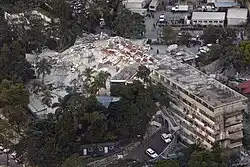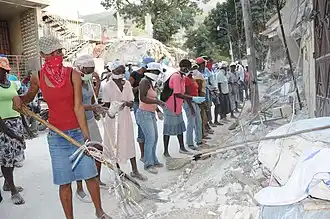
The 2010 Haiti Earthquake was an estimated 7 magnitude earthquake which struck Haiti on the evening of the 12th of January 2010. The earthquake’s epicenter was in the town of Léogâne, which lies just 25 kilometers to the west of the capital of Haiti, Port-au-Prince. The latter is a city of some two and a half million people and for decades has seen construction work of a poor quality owing to the general poverty and instability of Haiti. As a result, the earthquake destroyed hundreds of thousands of homes and the collapsing buildings led a very high mortality rate from the earthquake. There is no agreement as to the exact death toll and it was possibly anywhere between 100,000 and 300,000 people, though consensus figures tend to cite around 150,000 deaths. Millions of people were displaced by the earthquake, triggering internal and external migration, much of it to the United States and other parts of the Caribbean and Latin America.[1]
Research your ancestors on MyHeritage
2010 Haiti Earthquake chronology of events2010 Haiti Earthquake chronology of events
The 2010 Haitian Earthquake ended up causing as much death and devastation as it did because of the endemic poverty and instability of Haiti as it has developed in the twentieth and early twenty-first century. This country on the western side of the island of Hispaniola was just the second independent country to emerge from the colonial era of the Americas, after the United States. This occurred following the Haitian Revolution of 1791 to 1804. It had a complex history of wars and revolts in the nineteenth century and was occupied by the United States for much of the first half of the twentieth century.[2]

Then, between 1957 and 1986, it suffered under the Duvalier dictatorships of Francois Duvalier and his son, Jean-Claude. They ran Haiti as a highly corrupt kleptocracy, resulting in the country becoming highly impoverished. On top of this, waves of natural disasters over the decades in the turbulent Caribbean created further problems. Poverty then led to very poor housing being built in sprawling suburbs and neighborhoods of the capital Port-au-Prince as it swelled from a population of quarter of a million people in the 1950s to one million by the late 1980s and then two and a half million by the late 2000s.[3]
The 2010 Haitian Earthquake struck on the 12th of January 2010. It was registered as a magnitude 7 earthquake. This, by itself, need not necessarily be a tremendously destructive earthquake depending on where it strikes. In the case of the Haitian Earthquake it was devastating, as the epicenter of it was Léogâne, a town which lies just over twenty kilometers to the west of Port-au-Prince. This means the capital city was struck almost as forcefully as Léogâne. Owing to the poor structural quality of the buildings in the city, hundreds of thousands of houses collapsed and caved in. Moreover, in the two weeks that followed dozens of powerful aftershocks occurred, compounding the devastation. Finally, the earthquake created localized tsunamis.[4]
This wave of destruction killed a sizeable proportion of the population of Port-au-Prince. Even a vaguely accurate figure has never been agreed upon. The government estimated that just under a quarter of a million people lost their lives. Some estimates placed it closer to 300,000. More conservative assessments suggested it could be as low as 70,000. Most studies presented years later, once the impact was better understood, believe the figure was probably somewhere between 150,000 and 170,000. Millions of people were displaced, either because their homes were damaged or completely destroyed. This in turn spurred a wave of external migration.[5]
Extent of migration caused by the 2010 Haitian EarthquakeExtent of migration caused by the 2010 Haitian Earthquake

An estimated three million people were displaced because of the earthquake. Many remained in Haiti and were soon able to return to their homes after repairs were carried out or made do in some other way. However, hundreds of thousands of Haitians were spurred to leave the country as a result of the tragedy, which came after decades of difficulties in a country with myriad problems. A large proportion sought a place to settle in the United States, while others travelled to other parts of the Caribbean or Central and South America. Many thousands even travelled as far afield as Brazil and Chile.[6]
The exact scale of the migration and where it was to is difficult to concretely identify. Many Haitians, for instance, have participated in migrant caravans that have travelled across the Darien Gap in Panama in recent years and then onwards through Central America to Mexico or the United States. This means they transited through South America, making it difficult to determine if these were, for example, Haitians who had moved to Venezuela many years before the earthquake in 2010 and were subsequently driven to migrate from Venezuela owing to the hyperinflation and economic collapse there in the 2010s, or who only relocated to South America after the earthquake. Issues like this make it difficult to tie down the precise impact of a natural disaster like the 2010 Haitian Earthquake on migration patterns.[7]
Demographic impact of the 2010 Haitian EarthquakeDemographic impact of the 2010 Haitian Earthquake

The exodus from Haiti slowed population growth in Haiti itself and caused a steep decline in the population of Port-au-Prince, albeit a temporary one. Abroad the migration which ensued in 2010 and 2011 led to an increase in the Haitian communities in the United States, Cuba, Venezuela, Mexico and several other countries. The demographic impact was shifting still years later. After President Donald Trump removed the Temporary Protected Status from Haitian refugees in the United States in 2017, thousands crossed the northern border into Canada. In doing so they added to the substantial Haitian community which now lives in cities like Montreal and Quebec. As of the 2021 census, there were 179,000 people of Haitian descent in Canada, a considerable proportion of which ended up there directly or indirectly as a result of the 2010 earthquake.[8] Hence, many people in decades to come will have a Haitian ancestor who moved through several countries in the decade or so after the 2010 earthquake.
See alsoSee also
Explore more about the 2010 Haitian EarthquakeExplore more about the 2010 Haitian Earthquake
- Haiti in Ruins: A Look Back at the 2010 Earthquake at National Public Radio
- Behind the Numbers: The Shadow of 2010's Earthquake Still Looms Large in Haiti at Internal Displacement Monitoring Centre
- Caribbean, Births and Baptisms, 1590-1928 records collection on MyHeritage
- Caribbean, Marriages, 1591-1905 records collection on MyHeritage
- Caribbean, Deaths and Burials, 1790-1906 records collection on MyHeritage
References
- ↑ https://www.ngdc.noaa.gov/hazel/view/hazards/earthquake/event-more-info/8732
- ↑ https://www.bbc.co.uk/news/world-latin-america-19548810
- ↑ https://www.macrotrends.net/global-metrics/cities/21133/port-au-prince/population
- ↑ Garvey Lundy, ‘The Haiti Earthquake of 2010: The Politics of a Natural Disaster’, in Journal of Black Studies, Vol. 42, No. 2, The Haiti Earthquake of 2010: The Politics of a Natural Disaster (March, 2011), pp. 127–130.
- ↑ https://www.ngdc.noaa.gov/hazel/view/hazards/earthquake/event-more-info/8732
- ↑ https://www.migrationpolicy.org/news/haiti-next-displacement-crisis-americas
- ↑ https://www.cfr.org/article/crossing-darien-gap-migrants-risk-death-journey-us
- ↑ Lara Gautier, ‘What links can be made from narratives of migration and self-perceived health? A qualitative study with Haitian migrants settling in Quebec after the 2010 Haiti earthquake’, in Journal of Migration and Health, Vols 1–2 (2020).
